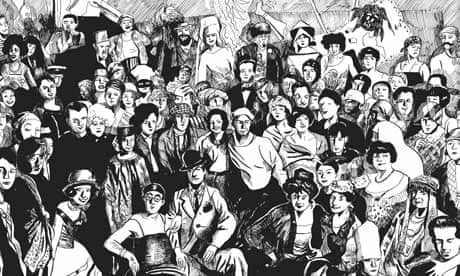One of the things I like about graphic books is the easy way they impart information. A few years ago, I read a fantastic graphic biography of Ronald Reagan (it's by Andrew Helfer, Steve Buccellato and Joe Staton, if you're interested). Would I be tempted to read a regular biography of the former president? No, I would not. But the juicy graphic equivalent could be devoured in its entirety inside two hours. Did it do the job, fact-wise? Oh, yes. A few months afterwards, I remember spouting off to a friend about some aspect of Reagan's time as governor of California in so much detail, and with such conviction, even I was somewhat startled (the friend in question looked gobsmacked and, possibly, a little bored).
I feel similarly about Kiki de Montparnasse, a new graphic biography of Alice Prin, the French model, nightclub singer and painter, whose face and body were immortalised in works by, among others, Fernand Léger, Maurice Utrillo and Man Ray, with whom she had a long and complex relationship. While I can't really imagine ever reading one of the many full-length books that have been written about Prin, who was born in poverty in 1901 in Châtillon-sur-Seine, and who died not much better off in 1953 and was buried in her beloved Montparnasse, I enjoyed this mightily. Not only is it funny, touching and occasionally rather rude; as an added bonus, a famous artist strolls across its pages pretty much every five minutes. It would be worth reading for its deft and concise portraits of men such as Modigliani and Picasso alone. No wonder that in France, where it was first published, it has already won several awards.
Prin's life had a picaresque quality (often itinerant, she was once falsely charged with working as a prostitute), which suits the comic strip form perfectly – and while it would be perfectly possible to claim her as a feminist icon, or at least as a somewhat early example of sexual emancipation, José-Louis Bocquet chooses instead to emphasise her pragmatism: most of the time, all she is really interested in is her next slap-up feed. Nor does he shy away from her less attractive qualities. Her fondness for sex results in a terrible blindness. One lover beats her, but she stays because he is simply too good-looking to leave. As for Catel Muller's drawings, they are full of life, each frame teeming with showgirls and drug addicts, poets and avant-garde film-makers. Her Kiki (this was Alice's nickname) is big-nosed, fierce, and steadfastly full of joy right until the end, when her body grows swollen with dropsy, her brain grows ever more addled with barbiturates, and her only source of income comes from selling on old shoes. She's captivating, and her story will send you racing into the nearest art gallery in search of her image cast in bronze or worked in oil – which is, of course, exactly what she would have wanted.

Comments (…)
Sign in or create your Guardian account to join the discussion